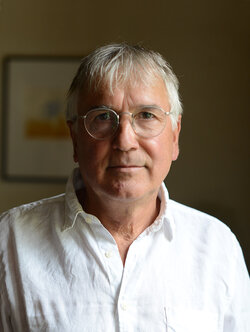Cinematographer Thierry Arbogast, AFC discusses his work on Atiq Rahimi’s “The Patience Stone (Syngue Sabour)”
By François ReumontHow was the film introduced to you?
Thierry Arbogast: I first learned about the project by reading the novel. What was wonderful was that this literary work is full of details and descriptions of the lighting and ambience one might find in Afghanistan. It was a very visual text despite the fact that practically the entire story takes place in the same room. Later on, one of the challenges in adapting the novel to the screen was to break up the story by adding outside shots that allowed the viewer to escape from behind the closed doors. Even though the film is mostly confined to the same room, it is nonetheless a very solar film because daylight truly dictates the rhythm both of the living patterns inside the house and the film itself.
Does shooting alongside a writer change the experience of filming?
TA: I truly had the experience of working with a writer who also has the soul of a director. His transposition of his novel will not disappoint his readers for he has truly created a visual restitution of the poetry of his book. Although he had to cut certain chapters or abandon certain things, I really believe that the force of his story is still there.
Was the film an easy sell?
TA: After two years of back-and-forth, the film suddenly found the necessary financing in just a few months and we had to suddenly begin location scouting and make choices in function of our modest budget (1.5 million €). The work schedule was planned over five weeks in Morocco and one week in Kabul for some of the outside shots, which really makes it seem that the entire story was filmed in Afghanistan.
Tell me about the Moroccan part...
TA: We filmed the inside shots in Casablanca in a run-down neighborhood. The surroundings were made to resemble a war-torn city. The walls were riddled with bullets and sometimes half collapsed. The house that was chosen was transformed into an Afghan home with the basement below and the traditional little patio. I immediately demanded that a northward facing house be chosen so that I wouldn’t have to battle with direct sunlight and to enable me to use an 18kW HMI as my principal light source. Most of the time, the set was lit with that source positioned in accordance with the time of day, and sometimes crossed with two other HMIs outside the house. Inside, I only added a polystyrene or reflector. So we artificially recreated filming conditions in natural light.
What camera did you use for filming?
TA: For the heart of the film in Morocco, I chose to use an Alexa in ProRes with anamorphic Vantage lenses (Hawk V-Lite 1.3). This combination allowed me to get the most out of the camera’s 16/9 sensor with a 1.3 aspect ratio, which gives an end result in 2.4:1. However, in Kabul, I used two Canon 5D Mark II, because our main priority was discretion. I used a 50mm anamorphic lens on those cameras with their 24x36 sensor, and that really helped us do the wide shots outside.
A lens that covers the 24x36?
TA: Yes, the lens belonged to Saba, my camera operator who is of Iranian descent. It is a lens made from a 50mm Nikkor 1.8 and a forward 1.5 aspect ratio Iscorama anamorphosis. This allowed us to use the full Canon sensor and get a 25mm spherical lateral field angle. For the shots requiring close ups (such as the quail fight), we filmed using classic photo zooming. Initially, the film editor was reserved regarding the direct transitions sometimes used within the same scene from indoors to outdoors, meaning from Alexa to Canon. After grading on Lustre where we slightly added contours to the images done with the Canon and a little bit on the definition, I can’t really tell the difference.
Did you filter?
TA: I hardly filtered at all, because I really like the image produced by the Hawk lenses. But I did use a bronze “glimmer” to diffract bright lights and create flares in sunbeams.
What about the nighttime shots?
TA: For the nighttime shots, I used a lot of oil lamps and pushed the Alexa to 1200 ISO (instead of the usual 800 ISO) and opened the shutter to 240 or 350° for the static scenes. Honestly, I know that some cameramen can’t stand doing that, but I have no scruples doing it so long as the Motion Blur doesn’t show up too much. Being a fan of Barry Lyndon’s, I like to film with completely natural candlelight and I think that if Kubrick had had modern technology at his disposal, he would have doubtlessly shot in digital and used these innovations and new tools to the best advantage.
Speaking of innovations, have you already been able to film with the Aaton Penelope Delta?
TA: No not yet, but I am eager to try it out. It’s true that the technique of recreating an image with a similar feeling to traditional silver-process film (with a target that randomly shifts a half-pixel with every frame) is truly appealing to me. But I am also really looking forward to wide sensor cameras (24 x 36 mm like the Canon 5D or 23 x 52 mm, which is equivalent to 70mm film). The wider the sensor, the more generous the image. It reminds me of my youth at the Kinopanorama, when I used to go to see movies on that giant screen…I was completely stupefied. For me, that was truly cinema.
(Interview conducted by François Reumont for the AFC)
 En
En
 Fr
Fr









